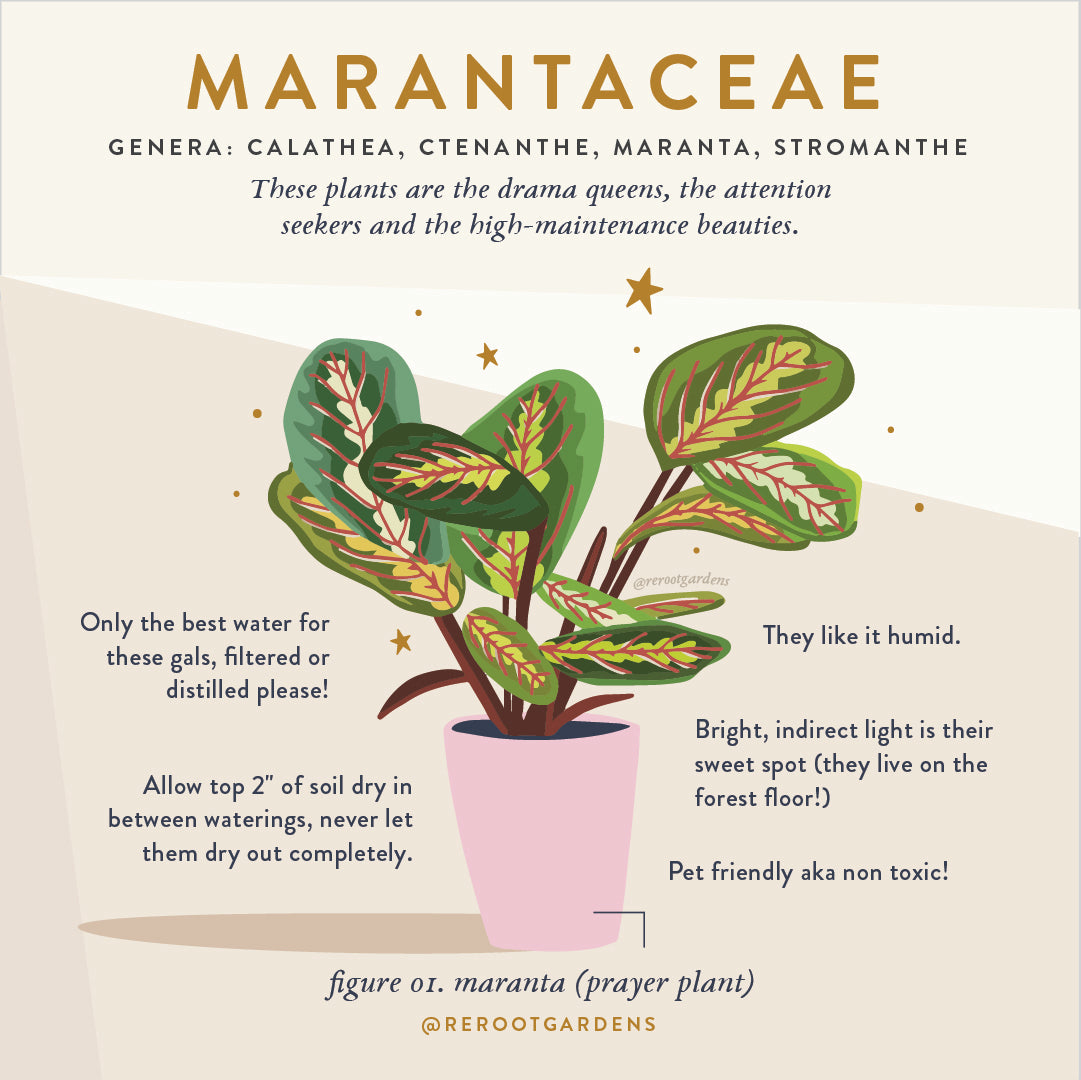
Introducing the drama queens of the indoor houseplant world, Marantas! This includes Maranta, Calathea, Stromanthe, Ctenanthe, any plants commonly known as "prayer plants."
Intro:
This family contains over 530 species! They can be found all over the world, including the Americas, Africa, and Asia, growing in tropic regions. While mostly used decoratively, some members are harvested for their edible starch, commonly referred to as Arrowroot.
These plants have some of the most striking, colorful and gorgeous foliage in the plant kingdom!
These plants live on the bottom of the forest floor which can tell you a lot about their growing habits and care; they like to spread out and typically don't get too tall but some species definitely do!
So why are they called "prayer plants?" During the day, they're leaves open up with the sun to collect as much light as possible. At night, these leaves close up in a "prayer" position, going to sleep for the night. It's believed they do this to keep their leaves dry at night, curled up to allow water to drain straight down to the roots. Remember, leaving water on the leaves for too long can lead to bacterial growth and damage and know that misting your plants is not a substitute for humidity, especially here in Colorado where we are borderline desert!
Read on to learn more about their specific care and how to care for your Marantaceae plant friend and keep her living her best life!
Lighting:
This plant family is the epitome of "bright filtered light" aka the brightest light possible without any direct sunlight, which ideally means a southern facing window with a sheer white curtain covering the direct rays. Sometimes you can get away with what's considered "low" light so it's a good plant for you apartment dwellers with lower natural light. A perfect plant for a few feet away from an east/west/southern exposure like on your bedside table or kitchen table.
Because these plants live at the bottom of the forest floor in their natural habitats, they receive the dappled light that has penetrated through the forest canopy. Always try to emulate a plants native conditions in your home for the best growth! Fun Fact: the undersides of some species in this family have a purple color, this is an adaptation to keep the light from penetrating through the leaves therefore allowing the plant to absorb as much light as possible. Neat!
Watering:
These plants get their reputation for being dramatic from their watering needs and requirements, if you start to see brown edges and you know she's getting plenty of humidity, you might need to change your water game. We recommend using filtered or distilled water especially for those who live in areas where the tap water is considered "harsh" or "mineral rich" aka city-dwellers!
Try to keep their soil consistently moist, they don't like to dry out for very long. If they do get too dry, they will let you know by dramatically folding and curling their leaves, looking almost dead but give that girl a full soak (be sure the water is room temp!!) and she should perk back up within a few hours (see below for other reasons her leaves might curl!). A general tropical mix that's not too porous and chunky but has some perlite and worm castings mixed in is a good option, check out our hand-mixed Tropical blend HERE.
Humidity:
Humidity is a must for these plants! Humidifiers are the best way to keep your humidity high and great for you too, especially if you live in a dry area like us here in Colorado. Great for kitchens and bathrooms with natural light. Pebble trays can be sometimes be effective and grouping similar plants together can also help with humidity. Remember: misting is NOT a substitute for humidity and can lead to other issues!!
Things to know:
-Leaf curling: when the outer edges of the leaves aka margins begin to curl inwards this can indicate either too much light, heat or she's thirsty!
-They can die back; if you start to notice yellowing leaves and you've done everything appropriate above, it's not you, it's your plant. Sometimes you may be looking at a clump of brownish stalks with one or two leaves. They are known to take breaks and go into dormancy, don't we all deserve a little break now and then?
-Flowers! These plants can sometimes bloom delicate little flowers. Props to you plant parent!
-Propagation: most of these plants must be separated and propagated via roots and cannot be propagated via leaf cuttings. However, Marantas can be propagated via stem cutting! Ensure there's at least one or two leaves on a vine and give her an angled chop, we recommend water propagation for these.





